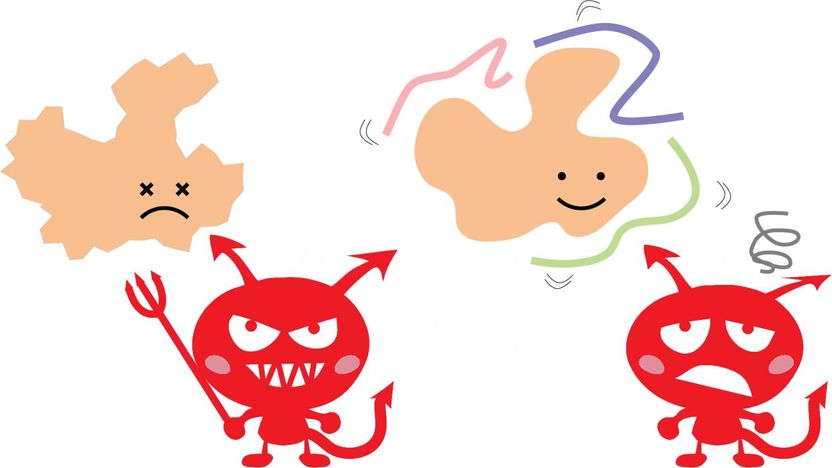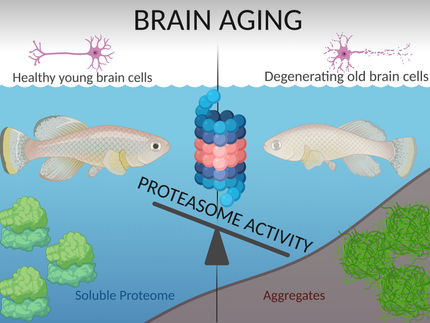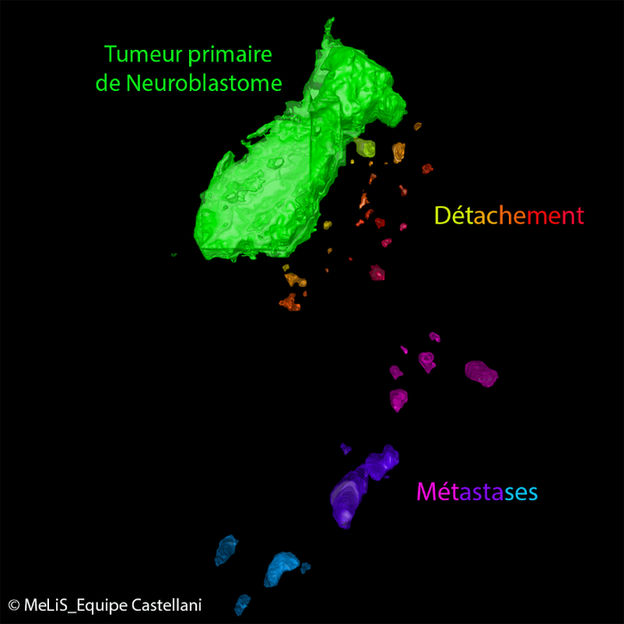Hero proteins are here to save other proteins
New group of proteins prevent dangerous clumps associated with neurodegenerative diseases
Researchers at the University of Tokyo have discovered a new group of proteins, remarkable for their unusual shape and abilities to protect against protein clumps associated with neurodegenerative diseases in lab experiments. The Hero proteins are heat resistant and are widespread in animals from insects to humans.

Damage (red devils) like drying out, harsh chemicals or heat normally causes proteins to become unstable and lose their proper shape and function (left side, orange). Researchers at the University of Tokyo have characterized Hero proteins (pink, purple, green), long, flexible proteins that protect other proteins (right side, orange).
Illustration by Kotaro Tsuboyama, CC BY 4.0
Most proteins have well-defined folds and twists that form a rigid structure, but the new type has a long, flexible stringlike structure. Researchers found the first of these strange proteins in flies and named it using a combination of an informal Japanese word meaning weak or not rigid and the diminutive suffix normally attached to young boy's names, "hero-hero kun."
Years later, researchers realized the name also fit the English meaning of "hero," a brave defender.
The UTokyo team now reports that Hero proteins can protect other proteins, extend the life span of fruit flies by 30 percent, and protect both fruit flies and lab-grown human motor neurons from dangerous protein clumps, like those observed in patients with neurodegenerative diseases.
An unlikely discovery
The Hero protein was identified by accident in about 2011 when then-graduate student Shintaro Iwasaki encountered an unusually heat-resistant protein that increased stability of Argonaute, the protein at the center of the lab's studies. Iwasaki now leads his own lab at RIKEN.
"It was kind of cool to know that a strange, extremely disordered, heat-resistant protein improved the behavior of Argonaute, but its biological relevance was unclear and, moreover, the protein's sequence seemed unrelated to anything else. So, we didn't know what to do next and just decided to put it on the shelf until years later," said Professor Yukihide Tomari, leader of the research lab and last author of the paper published in PLOS Biology.
Eventually, Kotaro Tsuboyama saw the hero-hero kun protein in a fresh light, initially after joining the lab as a doctoral student and now as a postdoctoral researcher.
Heroes in disguise
Proteins with similar functions usually have similar amino acid sequences even between different species; experts call this evolutionary conservation.
The lack of evolutionary conservation that Tomari's team encountered when they first identified hero-hero kun seems to be a defining characteristic for Hero proteins, making it difficult to predict their function or even identity.
To uncover the true identities of more Hero proteins, researchers grew human and fruit fly cells in the lab, made extracts from the cells, then simply boiled them.
High temperatures normally weaken chemical interactions that support a protein's structure, causing it to unfold and clump together with other unfolded proteins.
"Proteins are generally damaged by heat, but we found that Hero proteins remain intact even at 95 degrees Celsius [203 degrees Fahrenheit] without losing function. It is a bit strange, which is why I think no one has carefully characterized these proteins before," said Tsuboyama.
Next, researchers used an analytic technique called mass spectrometry to identify any proteins that remained in the boiled test tubes.
They found hundreds of Hero proteins in fruit flies and in humans.
Heroes to the rescue
Tsuboyama selected six Hero proteins to study in detail.
When some of the six Hero proteins were mixed with other "client" proteins, those clients kept their shape and function despite high heat, drying, or harsh chemicals that would normally destroy them.
In experiments using lab-grown human motor nerve cells, high levels of Hero proteins stopped cells from developing the protein clumps characteristic of the neurodegenerative disease amyotrophic lateral sclerosis (ALS) and restored their normal growth patterns.
The large, sensitive eyes of fruit flies are often used as disease models, because they are deformed by mutations that cause neurodegeneration in humans. Researchers observed that enhancing Hero activity protected flies' eyes from deformation caused by protein clumps associated with ALS. Conversely, eliminating normal Hero activity caused defects in the development of the fly eye.
Moreover, researchers found evidence that Hero proteins can promote longevity when they genetically modified healthy fruit flies to have high levels of individual Hero proteins throughout their whole bodies. Remarkably, some Hero proteins caused flies to live about 30 percent longer lives.
"It appears that Hero proteins naturally exist to keep other proteins happy," said Tomari.
To be continued...
"We saw many positive effects, but so far, we did not find any 'superhero' among those six Hero proteins that can stabilize all client proteins. Some Hero proteins are good for some clients, and others are good for other clients," said Tsuboyama.
Researchers are planning future experiments to identify any patterns or rules about which Hero proteins assist which client molecules in living organisms.
"We hope that, in the long run, Hero proteins can be useful for biotechnological and therapeutic applications," said Tomari.






















































